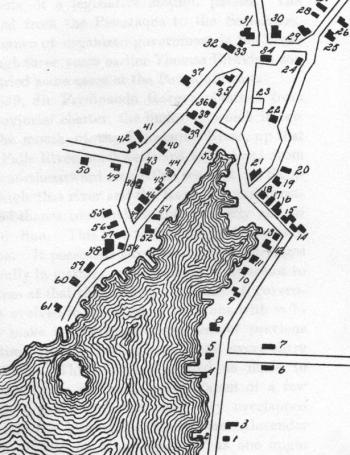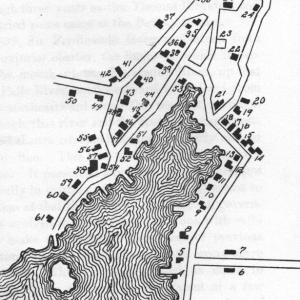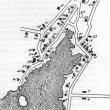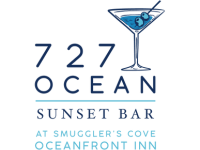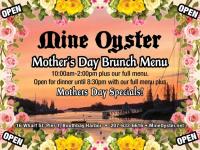Boothbay in 1836
This article was printed in a Dec. 22, 1836 Bath newspaper, “The Telegraph.” It’s interesting to see mention of the early 1660s colony in East Boothbay though it was mistakenly attributed to Germans at a too early date; to have Dunbar’s 1729 plans described; and to find, even 164 years ago, that Boothbay was already a tourist town. But prejudice against Indians and hazy imaginings upended the truth in the essay. It seems to be a period puff piece to throw a romantic glow on the area. Barbara Rumsey
Boothbay is one of the oldest settled places in Maine, having been settled by Europeans about as early as Pemaquid, and not later than 1630. At Damariscove island and also on a narrow carrying place between the head of Linekin’s Bay and Hodgdon’s Mills [at Murray Hill in East Boothay]; here have been found marks of settlement over and around which nature, during ages and even centuries, has been doing her work of demolition and covering with her moss and herbage, the time-worn relics of man.
At each of these places are even visible the remains of other vestiges of dwelling houses which time could not entirely destroy. Cellars, in many instances have been discovered with the stone walls still remaining around them, various copper and iron implements of cooking, some of husbandry and some mechanic’s tools have, within a few years been found in the immediate neighborhood, of the bottoms of chimneys, embedded several inches and sometimes a foot below the surface.
The present inhabitants have seen quantities of decayed bones lying together above the common surface of the ground, with banks of earth thrown over them. One of these mounds was thrown open some 25 years ago and the contents pronounced by Hon. Daniel Rose, who was then an inhabitant of Boothbay, to be human bones.
Like Pemaquid, the peculiar shape of the tools discovered, and the apparent design in arranging dwellings, induce the antiquarian to believe that the long-forgotten people who once inhabited this place were Germans. This peninsula was formerly called Cape Newoggin and was purchased of the famous Indian Sagamore, Robin Hood by Henry Curtis [he lived at West Harbor] in 1666 and soon became a principal settlement of the coast. In 1688 it was destroyed by the neighboring savages whose relentless ferocity, murdered the almost defenseless inhabitants and laid waste their dwellings. For 40 years after this catastrophe the Indians remained in full possession of the place without a rival.
Col. David Dunbar who revived the settlement at Pemaquid in 1729, laid claim to Cape Newoggin, offered protection to the inhabitants and called the place Townsend. On a pleasant elevation to the east of Townsend Harbor he projected a large fortification and called it Citadel Hill. From this time the place became one of the important infant settlements which were making around it, and the savages, finding the white man’s arms rather troublesome, receded to safer situations.
In the reign of George II the land around the harbor was surveyed in lots of a fourth of an acre each, preparatory for a city, with the design of having an important naval station there but, like many of the dreams and imaginations of men, the city and the Citadel on the hill adjoining, with all their importance, strength and grandeur, were but phantoms of the day and existed only in the fancy of the projectors. A small village indeed occupies the location of the city, while a few spruces and fir trees take the place of the implements of death on Citadel Hill.
Boothbay is a pleasant and on the whole a flourishing town, the inhabitants of which, like most of the settlements along the shores of New England, pursue the different occupations of agriculture, fishing and commerce.
As many of the inhabitants are interested in navigation, its young men often brave the perils of the ocean and venture their lives and fortune on its bosom. About 30 large vessels and sometimes like 70 fishing schooners are sailing from this place.
Boothbay Harbor is one of the safest retreats for shipping in Maine. It is not an unfrequent occurrence for 200 or 300 sail of vessels to be seen here at one time for shelter, and a gentleman of the first respectability informed me that he had, in a few cases, known 400 to be hovering in the bay.
This bay presents a romantic appearance. The ragged rocks with shelving sides, the cragged cliffs and intervening dales, which diversify the shores, forms a striking contrast with other portions of the same neighborhood and render a sail around the harbor in summer, a desirable pastime for parties of pleasure and a pleasant excuse for invalids.
At the end of the bay is the principal village. It is a pleasant settlement of about fifty dwelling houses, most of which are well finished and handsome. There are two houses of entertainment one on each side of the harbor, fitted up mostly for the accommodation of parties and invalids, several hundred of whom resort here in warm weather for exercise, air and scenery. In this town are three houses of public worship: Congregationalist, Methodist and Baptist and one Free [Free Will Baptists]. Each of these societies has a resident clergyman. There is also a respectable physician in the place, but as for lawyers, those fearful appendages of society, those hard-faced imperatives—I believe none are supported here.
The inhabitants of Boothbay have farms and fishing boats, good houses and good shops and I have reason to believe as good a proportion of needful things as any of their neighbors—with no lack of hospitality to strangers and quiet and contentment among themselves.
Event Date
Address
United States


